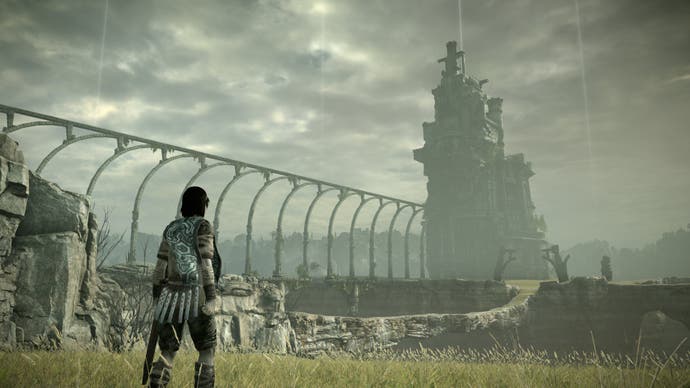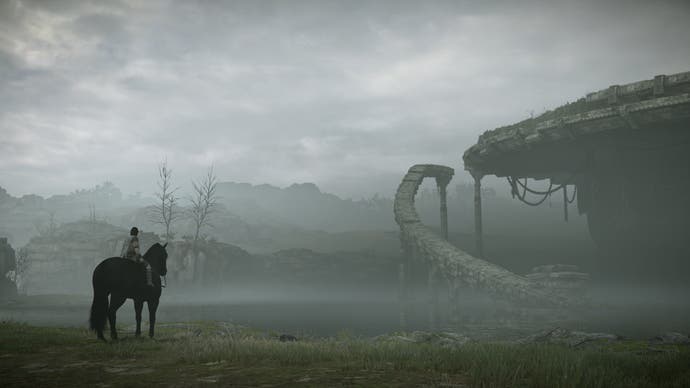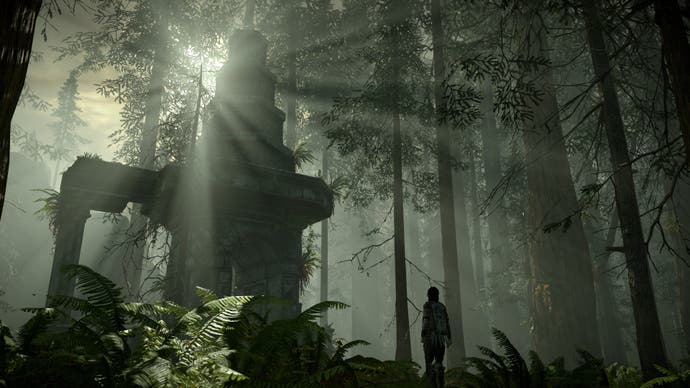The question of fidelity and Shadow of the Colossus
Wanderer above the sea of textures.
Editor's note: Once a month we're lucky enough to be graced by the presence of Gareth Damian Martin, editor of Heterotopias, to share some proper insight before we go back and default to just writing about PUBG and Destiny 2. If you want to read more in-depth critical writing, you can find a Heterotopias bundle celebrating the zine's anniversary here.
As someone who spends much of their time with games thinking about and photographing their spaces, architecture and worlds, I often forget that these are spaces we never truly enter. While our minds might seem to wander past the screen, it's a hard border for us, one we can never pass. In truth it seems that game spaces aren't true spaces at all, but images of spaces, presented at the steady clip of 30 or 60 frames per second. Why does this matter? Because while games may be the bastard child of art and architecture combined, it's worth remembering that their pre-digital history is one that connects to the history of images, and images of spaces, before it does to the history of architecture or spaces themselves.
All this became immediately evident to me when I encountered the upcoming remake of Shadow of the Colossus. Here was a space I knew intimately, that I had spent huge volumes of time in (or at least imagining I was in) being reshaped, changed, even transformed. And yet it wasn't the space itself that was changing, but the image of it. The volumes of sloping hills, the rolling surfaces of windswept planes, the scattering of haggard crags, all were matched to the original games layout as if part of a ritual of recreation. Each one was mirrored to the spaces I knew and had let sink into my memory. But the way these spatial elements, these landscapes and massings, manifested as images was changed totally.
It's a question of fidelity, a word that is linked more to image than it is to space. We often use that word to describe game worlds, and their startling reproduction of the detail and depth of real spaces and landscapes. When I looked at the remake of Shadow of the Colossus, fidelity is what I saw. What was once an expressionistic, flat shaded block of grey in the original game, a suggestion of a cliffside, became a description of a cliffside, with each of its multitude of cracks and stains, splits and colours evident to my eyes. In the remake this level of fidelity betrays its split attitude. After all, fidelity is a word that refers to recreation, exactitude, and in its original meaning, faithfulness. But this remake isn't faithful to the original alone, but to reality too. When we talk about its fidelity, we aren't just talking about a faithful recreation of the qualities of the original game, we are also talking about a reproduction of the images that the original game itself was derived from.

The result is a kind of particularity that feels totally estranged from the original game. While Shadow of the Colossus, in its washed-out, blur and bloom-laden original form felt like it was describing the sense of a place, its remake is describing the place itself. There's something unshakeable about its level of detail, a feeling of exactitude that is totally different. When I see a rock face in the Shadow of the Colossus remake I am looking at a particular rock face, a particular rock, a particular scraggly shrub. Their detail solidifies them into distinct objects in a way that the hazy props the original game never did. Together they assemble what is an undeniably particular landscape, one that might even have a 1:1 match in reality. In comparison, the original's hazy, grassy plains felt like a dream, something half-forgotten, already lost.
I'd go so far to say that this difference is not just a difference of fidelity, but a difference of language. To me it's like comparing the landscapes of the writer Mervyn Peake, nascent and obscure as they are ("a land of absolute stillness - a stillness of breath indrawn" or "the core of the castle lay heavy with sleep and smothered in ivy like a bitter veil") to the near scientific detailing of a writer like Cormac McCarthy ("A strand of cottonwoods where the ground held moss of a fiery nitric green" or "the country was low and swampy, sawgrass and tule, tufted hummocks among the scrub trees"). Both writers have their qualities, but each is different from the other. Peake works within the world of fantasy and dreams, but always grounding them in an earthy tone, while McCarthy build a world of particular words for particular plants, a biologist's landscape. Yet this comparison falls short, as we are not talking of language, we are talking of images. So perhaps a painter might serve us better.

As painters go, it's hard to think of one more influential on games and the images they craft than Caspar David Friedrich. He may have died in 1840, but his most famous painting, "Der Wanderer über dem Nebelmeer" or The Wanderer Above the Sea of Fog, has gained a kind of immortality though its countless imitations. Perhaps the most well-known example of that romantic staple, the Rückenfigur, a figure seen from the back looking out across a landscape, its trace can be seen in everything from the cover of Breath of the Wild to countless film and TV posters. It even makes an appearance in Minecraft, though as a particularly low fidelity version. But even more than that, Friedrich's image of the lone male figure, staring out across the peaks of a mysterious landscape, is really the proto-image for third-person open-world games themselves. Like our avatars in those games, Friedrich's Wanderer mediates between our external perspective and the internal space of the painting itself. We cannot pass through the canvas and enter the landscape in front of us, but through the wanderer we place ourselves in that world. Looking upon Friedrich's painting is to place ourselves as the wanderer, imagining ourselves at the peak of the mountain, surveying the landscape. In the same way, our avatars in games like Breath of the Wild, Witcher 3 or Shadow of the Colossus serve the same function, distinguishing figure from landscape, and providing a vessel into which we can place our own experience.
Shadow of the Colossus' Rückenfigur, neatly enough, is even called Wander. And it is through his placement in the foreground of every image of that world that we imagine our own place in it. But there's another connection to Friedrich's image that I want to tease out here, one that relates to our issue of fidelity. Because while at first glance Friedrich's painting seems to convey a fairly accurate landscape, rendered in a realistic style, on closer inspection it starts to become less clear. The rocky features that make up the landscape being vague and barely finished, marked with the patterns of trees that are little more than stipple marks. The distant landscape, two downward arcs with a mountain and an outcrop behind, are flat, fuzzy shapes, carefully shepherded into suggestive forms. In fact, beyond of the figure and the carefully detailed rock that props him up, the landscape fades into indeterminate forms, disconnected, not a landscape at all, but a set of soft-edged forms with imagined connections between. It's that sea of fog, the Nebelmeer (what a word!) which allows this, with its almost cartoonish wind-whipped shape, dramatically shrouding the disparate rocky islands. In its shape, movement, and tone is all the drama of this image, all its life, and once you look away, all its detail. Because the interesting thing about The Wanderer Above the Sea of Fog is the way it plays in your memory, slowly filling in with invented detail and a slowly accruing sense of life.

That's the strange thing about fidelity; that ultimately it undoes what it seeks to represent. The more that is described, the more that is defined about an image, the more settled it is. If everything is cleanly detailed, fully visible, and in its proper, well composed place, then what space is there for us to inhabit? Even with a Rückenfigur at the centre of the image we find ourselves blocked, unable to access the space. Instead of wandering we are fixed in place, assaulted by the details on all sides. At times, the remake of Shadow of the Colossus can feel like this. The fidelity of its rock faces and trees, the sheer volume of foliage and individual blades of grass serves a purpose that feels like it's lost its way. It's as if we began to paint over Friedrich's image, carefully turning his stipple marks into definite trees of a definite species, his odd rocks into realistically eroded limestone and granite. And perhaps as a final gesture, we might "defog" the image (to use a technical term), to reveal the landscape beneath. Or maybe we'd just repaint his strange Nebelmeer, turning it from a shifting, imagined form into the undifferentiated white-grey that more accurately represents real cloud.
The result might be impressive, it might be technically astounding, packed with the kind of details that get affirmative nods and dedicated reddit posts. It may even turn heads that would otherwise ignore the "outdated" look of the original. But the language would have changed, the tone of description, even the provenance of the image. It would be cut off from a history of figures stood before indefinite, magnetic landscapes, and instead connected to a ceaseless pursuit of recreation, of accuracy, of definitive detail. Tethered to fidelity like a leash. And thinking like this, it suddenly strikes me as strange that the root of the word fidelity might be the Latin word for "faith", because an image of the highest fidelity requires no faith at all.

